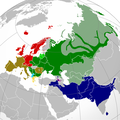Faili:Indo-European branches map.png

Ukubwa wa hakikisho: piseli 599 × 600. Ukubwa zingine: piseli 240 × 240 | piseli 479 × 480 | piseli 767 × 768 | piseli 1,023 × 1,024 | piseli 2,045 × 2,048 | piseli 2,934 × 2,938.
Faili halisi (piseli 2,934 × 2,938, saizi ya faili: 2.16 MB, aina ya MIME: image/png)
Historia ya faili
Bonyeza tarehe/saa kuona faili kama ilivyoonekana wakati huo.
| Tarehe/Saa | Picha ndogo | Vipimo | Mtumiaji | Maelezo | |
|---|---|---|---|---|---|
| sasa hivi | 03:43, 26 Septemba 2022 |  | 2,934 × 2,938 (2.16 MB) | Alexikoua | minor fixes |
| 15:58, 30 Machi 2022 |  | 2,934 × 2,938 (1.74 MB) | Whoop whoop pull up | Whoops, wrong file! | |
| 15:37, 30 Machi 2022 |  | 2,048 × 2,048 (980 KB) | Whoop whoop pull up | Misc fixes (Russian minority in Svalbard & Israel, Slovenian in SE Carinthia, Greek in N Epirus, Aromanians/Megleno-Romanians, Swedish essentially extinct in Estonia, etc. | |
| 09:37, 22 Desemba 2021 |  | 2,934 × 2,938 (1.74 MB) | Ahmet Q. | Reverted to version as of 19:55, 23 August 2021 (UTC)seek consensus for your changes | |
| 20:40, 25 Novemba 2021 |  | 2,934 × 2,938 (2.16 MB) | Alexikoua | rv elimination of Greek minority in Albania | |
| 19:55, 23 Agosti 2021 |  | 2,934 × 2,938 (1.74 MB) | Ahmet Q. | Rv false edit summary. Overrepresentation of Greeks in Turkey, Albania and Ukraine. Unexplained removal of Romanian in Serbia. Overall deterioration of the original file. Seek consensus for your changes. | |
| 16:16, 7 Agosti 2021 |  | 2,934 × 2,938 (2.16 MB) | Demetrios1993 | Addition of Arbereshe linguistic minority in Sicily. Addition of Serbian, Bosnian, and Gorani linguistic minorities in Kosovo. Addition of Greek linguistic minorities in Italy, Albania, Turkey, and Ukraine. Including some other minor corrections. | |
| 17:00, 19 Novemba 2020 |  | 2,934 × 2,938 (1.74 MB) | Golden | update Armenian | |
| 18:42, 31 Machi 2018 |  | 1,479 × 1,479 (574 KB) | Maphobbyist | Removed area that exactly corresponds to the non-Indo European Lezgi linguistic area. | |
| 21:37, 6 Septemba 2016 |  | 1,479 × 1,479 (620 KB) | Rob984 | Georgia and Azerbaijan aren't majority multilingual. Older generations speak Russian from the Soviet era but now English is taught mainly in place of Russian. More people speak English in Finland, yet that isn't coloured. Also corrections to Celtic are... |
Matumizi ya faili
Ukurasa huu umeunganishwa na faili hili:
Matumizi ya faili ulimwenguni
Wiki nyingine hutumia faili hizi:
- Matumizi kwa ast.wikipedia.org
- Matumizi kwa ban.wikipedia.org
- Matumizi kwa be-tarask.wikipedia.org
- Matumizi kwa be.wikipedia.org
- Matumizi kwa bg.wikipedia.org
- Matumizi kwa cs.wikipedia.org
- Matumizi kwa da.wikipedia.org
- Matumizi kwa de.wikipedia.org
- Matumizi kwa en.wikipedia.org
- Matumizi kwa en.wikiversity.org
- Matumizi kwa es.wikipedia.org
- Matumizi kwa et.wikipedia.org
- Matumizi kwa eu.wikipedia.org
- Matumizi kwa fa.wikipedia.org
- Matumizi kwa fi.wikipedia.org
- Matumizi kwa frr.wikipedia.org
- Matumizi kwa fr.wikipedia.org
- Matumizi kwa gl.wikipedia.org
- Matumizi kwa gu.wikipedia.org
- Matumizi kwa gv.wikipedia.org
- Matumizi kwa hak.wikipedia.org
- Matumizi kwa he.wikipedia.org
- Matumizi kwa hy.wikipedia.org
- Matumizi kwa hyw.wikipedia.org
- Matumizi kwa ilo.wikipedia.org
- Matumizi kwa incubator.wikimedia.org
- Matumizi kwa io.wikipedia.org
Tazama matumizi zaidi ya kimataifa ya faili hii.



